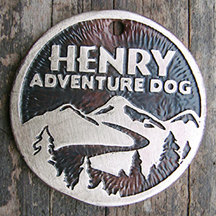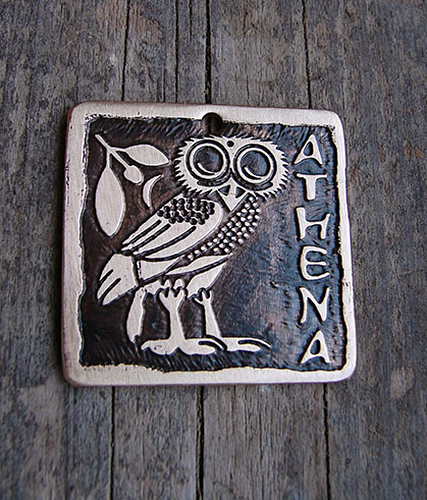The treatments such as Cermak and thermal work quite well. There is a good explanation with diagrams of how the chemical process works. It is clearly additive and not etching. Go to thermark.com and select “how it works”.
Dan (and anyone who sees this),
I am trying to figure out what equipment or process I need to etch brass to I can create products of the same quality as this example I found on etsy (see photo). What I like about her piece is that it has depth in addition to detail.
If I mask a brass blank do you think I can engrave it so this much depth is revealed?

Her storefront has this piece under the category of Brass Etched. So, I am super duper hoping to be able to also attain this much depth in my pieces. I have access to a water jet, so I know I can cut metal silhouettes/shapes, but I also want to get some cool detail and depth onto my metal through engraving or etching.
I’m sorry if you answered this question 3,000 times already, I have not seen any photos of etched or engraved metal pieces made using the glowforge.
Thank you bunches!
Michelle Hamilton
Liberty Hill, TX
The Glowforge will not be able to etch the brass directly. It doesn’t have the wattage necessary for that. People have suggested putting a mask on the part, cutting away areas with the Glowforge and then etching it chemically. Unfortunately, I do not believe that technique will be able to give you the level of detail in the part you have pictured.
Personally, if I was going to look into making multiple pieces with that level of detail, I would make a positive with the Glowforge out of some easily cut material, make a mold from it, then cast the brass. But that might also be because I want to try learning more metal working skill. 
Thank you, Joe. This is a drag, I was really hoping it would work.
On a side note, I just did a pinterest search for etched metal and there are photos which look like some people made some cool etching/engravings… It may be chemical etching… Here’s a link to the results I found:
If you do any etched metal work, please post photos and feel free to email me again. (-:
Thanks for the super fast reply,
Michelle Hamilton
While @joe is correct in that the Glowforge cannot directly cut or etch ANY metal, I disagree about the detail. If @dan and Co are able to get the precision they have described (and I am sure they will) then we should be able to mask/laser/etch and get great details!
The depth is the hard part. Etching has a tendency to undercut and break through the resist when you try to etch deeply, but careful attention to process can make it work. Commercially it is often done with “spray etching” where the chemicals are actually sprayed onto the surface so they don’t get a chance to sit there and make undercuts. Usually you put the work upside-down over the spray. This is obviously tricky to set up, and spraying acids around is not for inexperienced or the faint of heart.  There are also safer techniques where you submerge the work in the acid and use an aquarium bubbler to keep the liquid moving around.
There are also safer techniques where you submerge the work in the acid and use an aquarium bubbler to keep the liquid moving around.
There are lots of good tutorials on chemically etching brass out there, and google is your friend. Here is one example http://steampunkworkshop.com/electroetch-shtml/
Be careful and be safe and you can get great results.
My uninformed guess would be chemical etching with ferric chloride as it appears to be pretty cheap, easy and can cut deep. As mentioned above, the glowforge should work well for masking the resist.
Other possibilities include using a CNC Mill, a metal cutting laser or casting as mentioned by joe. If you follow the “Mini Founry” link in this post you can see an example of a backyard foundry. I just like the idea of a backyard foundry and encourage it whenever I have the opportunity.
Sorry, I should have been clearer. I was talking about the bumps and shapes at the bottom of the cut outs. I did not mean the actual shapes. Can chemical etching make those shapes? I’m did not believe it could, but I could be wrong.
No worries @joe, that is a very good question. I think that is a side effect of the way the original is being etched. It is hard to tell from that tiny picture, but if you look carefully around the perimeter of the etched area you can see a break in the pattern of grooves radiating out. That is a really good sign that there were lots of bubbles in the etch that “stuck” to the edges and then released leaving those tracks. I know it sounds crazy but you can actually watch an etching bath (don’t breath too much) and see this stuff happening. Some times the accidental effects are the best part. 
That could very well be a casted piece. You could make a blank out of wood then make a cast for you to pour brass into, then color treat the background…
Huh, I didn’t know that. Now I’m going to have to youtube etching baths when I get home. I had just assume they were intentional because the trees on the bottom right looked very cool. 
The most I’ve ever chemically etched was identification marks on parts, but that was electrochemical process and wasn’t very deep.
I found the original site those images came from and there are some larger pictures showing what I mean.
You can see the bubble tracks in the background, and some porosity around the edges where the resist broke through (none of that is bad, just an observation).
When I was in school we were taught to use a feather to brush away the bubbles and try to get a flat background.
If you were able to get a flat background in the primary etch, you can just create a second mask that sits inside the first etching, and masks the second etching. Then you get a nice flat initial etch, but also some second-level details etched deeper.
That’s a good idea to use the GlowForge and then do the chemical acid etch. I might try that.
I don’t have unlimited internet, so went to Starbucks yesterday to borrow theirs, and downloaded youtube videos about etch- ferric - chloride… That appears to be how the deep etching was achieved… I’m going to watch the videos in a few… (-: Thank you for the reply!
Michelle
I watched some youtube videos about bronze casting into molds, and it was interesting, and could work if you just have one design and want to make many. My plan or desired goal is make many cool designs and each one be personalized… ie, I seek the best, deepest etch with clarity and the fastest result with the least work. (-:
Jkopel - You found her page… Isn’t her stuff amazing? (-: You seem to be familiar with the acid etch process… By any chance do you have a favorite method or chemical mix to suggest so I can get a result like this owl dog tag? She etches both sides of the tag with personalized name and address info, I imagine she can do a 2 for 1 with one acid bath.
I haven’t watched the videos I downloaded yesterday about etching metal with ferric chloride… If you have any suggestions, I’d love to hear them. Right now, I am leaning towards this process, IF you think this is how she achieved this owl etching…
Thank you for your replies. I wish I posted to this GlowForge thread a month ago!!! I’ve been banging my head trying to find a mechanical (machine) method to get this result. On another post, someone replied and mentioned a fiber laser… something I never heard of before, but the image he posted looked awesome.
I found out about the ferric chloride etching after visiting this web page:
She posts some pictures that look very similar to the dog tag…
Anyway, thank you all for the info and the replies.
Michelle
It is hard to tell what process was used, but Ferric Chloride is a great one to experiment with as a beginner. It is relatively safe and almost foolproof. That tutorial you linked to looks like a good one. I like that it encourages lots of surface preparation (i.e. clean clean clean) as will help yield the best results. It is amazing how easy it is to get beautifully etched copies of your greasy fingerprints…
Fiber lasers are amazing, but they are also amazingly expensive, especially if you want to be deeply cutting into brass. Etching works better than many (if not all) mechanical processes for this application. It is inexpensive and quick, and the level of detail you can get with proper process is simply amazing. You can also play fast and loose and get all kinds of cool side effects, but best to start out with trying to do it “right”.
Thank you so much, I’ve ordered my materials to start ferric chloride etching. I was shocked at how hard it was to get copper and brass. I’m having to start with stainless steel that I cut on water jet.
Anyway, I ramble, thank you for all your input!
Are you looking for pre-cut shapes?
If not then there are quite a few online suppliers.
My personal favorite is online metals, but this mainly because they have a local will call office and I can save on shipping.
https://www.onlinemetals.com/merchant.cfm?id=1116&step=2&top_cat=79
https://www.onlinemetals.com/merchant.cfm?id=1348&step=2&top_cat=87
